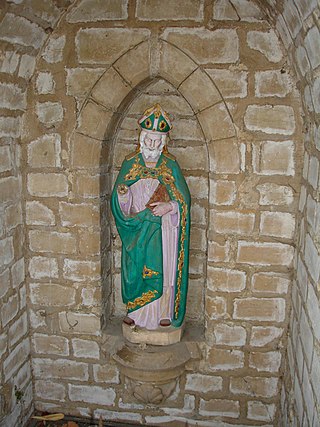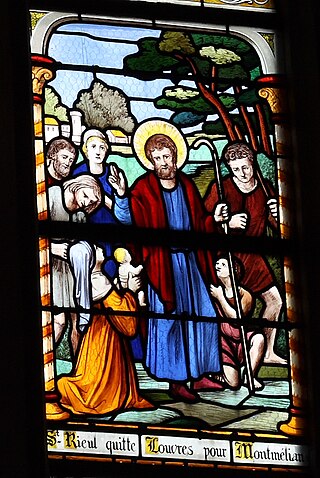
Year 673 (DCLXXIII) was a common year starting on Saturday of the Julian calendar. The denomination 673 for this year has been used since the early medieval period, when the Anno Domini calendar era became the prevalent method in Europe for naming years.

Ebroin was the Frankish mayor of the palace of Neustria on two occasions; firstly from 658 to his deposition in 673 and secondly from 675 to his death in 680 or 681. In a violent and despotic career, he strove to impose the authority of Neustria, which was under his control, over Burgundy and Austrasia.
Wilfrid was an English bishop and saint. Born a Northumbrian noble, he entered religious life as a teenager and studied at Lindisfarne, at Canterbury, in Francia, and at Rome; he returned to Northumbria in about 660, and became the abbot of a newly founded monastery at Ripon. In 664 Wilfrid acted as spokesman for the Roman position at the Synod of Whitby, and became famous for his speech advocating that the Roman method for calculating the date of Easter should be adopted. His success prompted the king's son, Alhfrith, to appoint him Bishop of Northumbria. Wilfrid chose to be consecrated in Gaul because of the lack of what he considered to be validly consecrated bishops in England at that time. During Wilfrid's absence Alhfrith seems to have led an unsuccessful revolt against his father, Oswiu, leaving a question mark over Wilfrid's appointment as bishop. Before Wilfrid's return Oswiu had appointed Ceadda in his place, resulting in Wilfrid's retirement to Ripon for a few years following his arrival back in Northumbria.

Dagobert II was a Merovingian king of the Franks, ruling in Austrasia from 675 or 676 until his death. He is one of the more obscure Merovingians. He has been considered a martyr since at least the ninth century.

Theuderic III was King of the Franks. He ruled Neustria and Burgundy on two occasions, as well as Austrasia from 679 to his death in 691.
Adrian, also spelled Hadrian, was a North African scholar in Anglo-Saxon England and the abbot of Saint Peter's and Saint Paul's in Canterbury. He was a noted teacher and commentator of the Bible. Adrian was born between 630 and 637. According to Bede, he was "by nation an African", and thus a Berber native of North Africa, and was abbot of a monastery near Naples, called Monasterium Niridanum.

Leodegar of Poitiers was a martyred Burgundian Bishop of Autun. He was the son of Saint Sigrada and the brother of Saint Warinus.

Audoin, venerated as Saint Audoin, was a Frankish bishop, courtier, hagiographer and saint. He authored Vita Sancti Eligii which outlines the life and deeds of Eligius, his close friend and companion in the royal court and the Church.

October 1 - Eastern Orthodox liturgical calendar - October 3
Martin was the count of Laon in the late second half of the 7th century.
Cybistra or Kybistra, earlier known as Ḫubišna, was a town of ancient Cappadocia or Cilicia.
Leudesius was the son of Erchinoald, Mayor of the Palace of Neustria, and his wife Leutsinde.

Jouarre is a commune in the Seine-et-Marne department in the Île-de-France region in north-central France.

Agilbert was the second bishop of the West Saxon kingdom and later Bishop of Paris. He is venerated as a saint within the Catholic Church, with his feast day falling on 11 October.

Praejectus, Prejectus or Projectus (625–676) was a bishop of Clermont, who was killed together with the abbot Amarinus as a result of political struggles of the day.

Clotilde or Chlodechilidis was the founder of the abbey of Bruyères-le-Châtel. Her charter is one of only eight known original manuscripts to survive from 7th century Francia, among which it is the only private charter. It is a parchment, which is unusual in that most surviving Merovingian documents of the 7th century were written on papyrus. As a result, it has been the object of detailed analysis over many years.
Saint Genesius of Lyon was the 37th Archbishop of Lyon.

Rembert Regulus (Rieul) of Senlis was the first bishop of Senlis. His feast day is March 30th.

The Battle of Lucofao was the decisive engagement of the civil war that afflicted the Frankish kingdoms during and after the reign of Dagobert II (676–79). In the battle, the Neustrian forces of Theuderic III and his majordomo Ebroin defeated the forces of Austrasia under the dukes Pippin and Martin.
Sigrada of Alsace was a Franco-Burgundian countess and mother of Ss. Warin, and Leodegar, and grandmother of St. Leudwinus.












